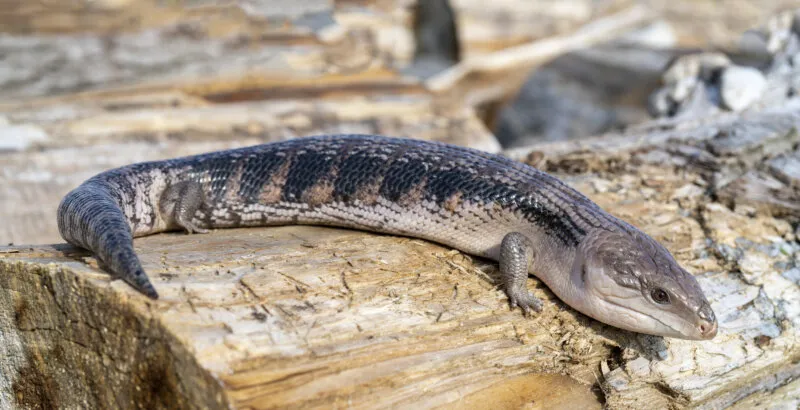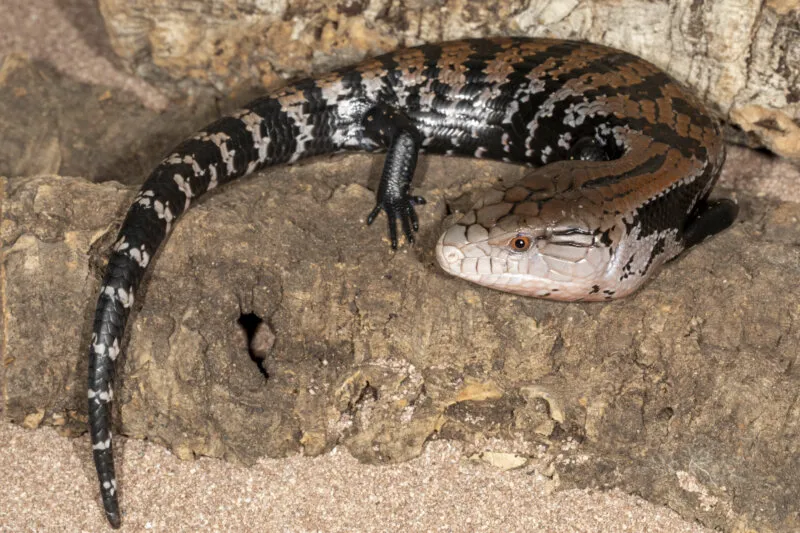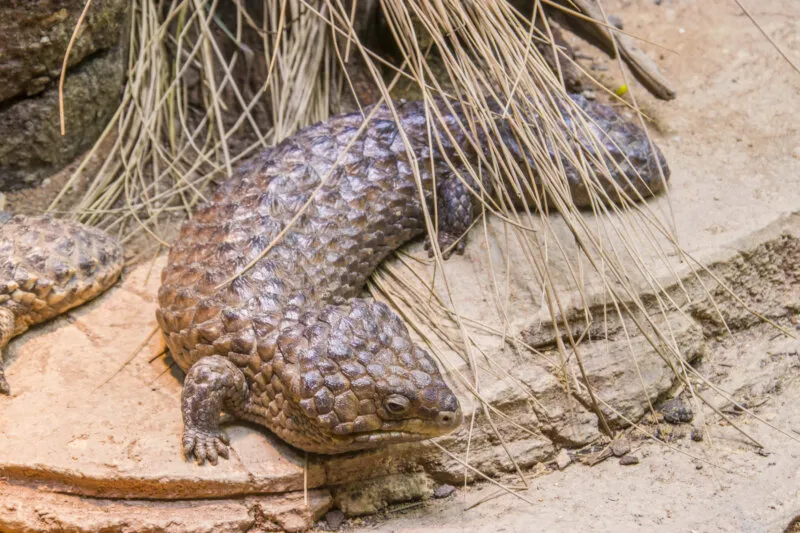
Blue Tongue Skinks are one of the biggest pet lizards available. Their impressive size makes them an exciting pet, but one that needs more space and more…well…everything! It’s important to be prepared for how large your skink could grow before you commit to caring for it for 20+ years. So, just how big can Blue Tongue Skinks get?
The Common Australian Blue Tongue Skink (Tiliqua scincoides) grows 23.6 inches in length from snout to tail. There are many species of Blue Tongue Skinks, but not all are kept as pets. They range between 7 inches and 29.9 inches in length.
Let’s delve deeper into the types of Blue Tongue Skinks that exist, which ones are kept as pets, and, most importantly, how big they can get!
Table of Contents
How Big Your Blue Tongue Skink Can Get Depends On The Species
There are many different species and subspecies of Blue Tongue Skinks, found in Australia and Indonesia.
The ones that are most commonly kept as pets are the Common and Blotched species from Australia, and the Giant Blue Tongue Skinks from Indonesia. You can spot these in bold in the diagram below.
The Australian Shingleback species are short, stocky, and heavy. They are also called bobtail lizards because their tail is so short. This makes their snout-to-vent length very similar to their overall length.
On the other hand, the Indonesian gigas species are generally the largest, but they have extremely long tails in comparison to their shorter body size.
Because there are so many species and subspecies spread across 2 regions, including some that are hybrids, it can be super confusing to identify your skink type. Check out the handy guide below to understand Blue Tongue Skink species.
Australian Blue Tongue Skink Species and Subspecies
- Common Blue Tongue Skink (Tiliqua scincoides)
- Eastern Blue Tongue Skink (Tiliqua scincoides scincoides)
- Northern Blue Tongue Skink (Tiliqua scincoides intermedia)
- Centralian Blue Tongue Skink (Tiliqua multifasciata)
- Western Blue Tongue Skink (Tiliqua occipitalis)
- Blotched Blue Tongue Skink (Tiliqua nigrolutea)
- Pygmy Blue Tongue Skink (Tiliqua adelaidensis)
- Shingleback Blue Tongue Skink (Tiliqua rugosa)
- Western Shingleback (Tiliqua rugosa rugosa)
- Rottnest Island Shingleback (Tiliqua rugosa konowi)
- Eastern Shingleback (Tiliqua rugosa aspera)
- Shark Bay Shingleback (Tiliqua rugosa palarra)
Indonesian Blue Tongue Skink Species and Subspecies
- Indonesian Giant Blue Tongue Skink (Tiliqua gigas)
- Classic Indonesian / Halmahera Blue Tongue Skink (Tiliqua gigas gigas)
- Kei Island Blue Tongue Skink (Tiliqua gigas keyensis)
- Merauke Blue Tongue Skink (Tiliqua gigas evanescens)
- Common Blue Tongue Skink (Tiliqua scincoides)
- Tanimbar Blue Tongue Skink (Tiliqua scincoides chimaera)
- Hybrid species = Irian Jaya Blue Tongue Skink (Tiliqua sp.)
The Irian Jaya is actually a hybrid between Indonesian gigas and Eastern scincoides Blue Tongue Skinks.
How Big Does Each Type Of Blue Tongue Skink Get?
Working out how large your Blue Tongue Skink could get is really hard work. Partly, this is because there are so many different average ranges published online.
Also, for skink species that aren’t kept as often as pets, it’s almost impossible to find their measurements or weight!
Below, I’ve compiled a handy table of the maximum sizes that are frequently reported for each species.
Australian Skink Species Biggest Sizes
| Skink Species | Skink Subspecies | Max’ Length Snout to Tail | Max’ Length Snout to Vent | Max’ Weight |
| Common Blue Tongue Skink (Tiliqua scincoides) | Eastern Blue Tongue Skink (Tiliqua scincoides scincoides) | 60cm / 23.6in | 32cm / 12.5in | 600g / 21.1oz |
| Common Blue Tongue Skink (Tiliqua scincoides) | Northern Blue Tongue Skink (Tiliqua scincoides intermedia) | 61cm / 24in | 40cm / 15.7in | 600g / 21.1oz |
| Centralian Blue Tongue Skink (Tiliqua multifasciata) | n/a | 45cm / 17.7in | 29cm / 11.4 | 510g / 17.9oz |
| Western Blue Tongue Skink (Tiliqua occipitalis) | n/a | 50cm / 19.6in | 27cm / 10.6in | 510g / 17.9oz |
| Blotched Blue Tongue Skink (Tiliqua nigrolutea) | n/a | 50cm / 19.6in | 29cm / 11.4in | 450g / 15.8oz |
| Pygmy Blue Tongue Skink (Tiliqua adelaidensis) | n/a | 19cm / 7.4in | 10cm / 3.93in | unknown |
| Shingleback Blue Tongue Skink (Tiliqua rugosa) | Western Shingleback (Tiliqua rugosa rugosa) | 45cm / 17.7in | 41cm / 16.1in | 900g / 31.7oz |
| Shingleback Blue Tongue Skink (Tiliqua rugosa) | Rottnest Island Shingleback (Tiliqua rugosa konowi) | 45cm / 17.7in | 41cm / 16.1in | 900g / 31.7oz |
| Shingleback Blue Tongue Skink (Tiliqua rugosa) | Eastern Shingleback (Tiliqua rugosa aspera) | 45cm / 17.7in | 41cm / 16.1in | 900g / 31.7oz |
| Shingleback Blue Tongue Skink (Tiliqua rugosa) | Shark Bay Shingleback (Tiliqua rugosa palarra) | 45cm / 17.7in | 41cm / 16.1in | 900g / 31.7oz |
Indonesian Skink Species Biggest Sizes
| Skink Species | Skink Subspecies | Max’ Length Snout to Tail | Max’ Length Snout to Vent | Max’ Weight |
| Indonesian Giant Blue Tongue Skink (Tiliqua gigas) | Classic Indonesian / Halmahera Blue Tongue Skink (Tiliqua gigas gigas) | 50cm / 19.6in | 30cm / 11.8in | 700g / 24.6oz |
| Indonesian Giant Blue Tongue Skink (Tiliqua gigas) | Kei Island Blue Tongue Skink (Tiliqua gigas keyensis) | 50cm / 19.6in | 30cm / 11.8in | 700g / 24.6oz |
| Indonesian Giant Blue Tongue Skink (Tiliqua gigas) | Merauke Blue Tongue Skink (Tiliqua gigas evanescens) | 76cm / 29.9in | unknown | 1000g / 35.2oz |
| Common Blue Tongue Skink (Tiliqua scincoides) | Tanimbar Blue Tongue Skink (Tiliqua scincoides chimaera) | 43cm / 16.9in | unknown | unknown |
| Hybrid of other Tiliqua species | Irian Jaya Blue Tongue Skink (Tiliqua sp.) | 60cm / 23.6in | unknown | unknown |
Are Male or Female Blue Tongue Skinks Bigger?
Generally, male and female Blue Tongue Skinks are pretty similar in size and appearance. Though it does differ a little between the species, there is not a lot of sexual dimorphism in Blue Tongue Skinks.
For all the Blue Tongue Skink species, female skinks tend to be a little bit longer in the body. Look at the distance between the shoulders of the front legs and hind legs to notice this elongation.
On the other hand, despite being shorter, males are usually heavier. They have a chunkier, stouter build. They also tend to have broader, wider heads. Be aware, however, that this is a generalization and not a reliable way to tell the gender of your pet skink.

How Big Are Baby Blue Tongue Skinks?
It differs from species to species. However, of the commonly kept pet species, the Eastern Blue Tongue Skink (Tiliqua scincoides scincoides) has the largest litters and smallest babies. They are just 13-14cm at the time of birth and weigh 10-20g.
How Long Do Blue Tongue Skinks Grow For?
Blue Tongue Skinks grow very quickly in the first year of their life. They may reach full length by 12-18 months old. However, they are likely to continue to change their appearance after this time, as they fill out and change shape.
Depending on their feeding regime, they may grow faster or slower. Skinks that are fed less frequently may continue growing more slowly until 2-3 years of age.
What Affects The Growth Of Blue Tongue Skinks?
Diet and Nutrition
Nutrition is the most important factor influencing how a Blue Tongue Skink grows. Skinks under the age of 2 years old need a diet made up of 70-80% protein.
Until the skink is full-grown, you need to feed them 50-60% protein. This means that more than half of their diet should be crickets, worms, snails, pinky mice, and possibly even some dog
It’s also a great idea to provide your Blue Tongue Skink with a calcium carbonate supplement to help with healthy bone development.
Metabolic Bone Disease
Metabolic Bone Disease is a very common health issue for reptiles, which causes weak bones. If it is left untreated, it will cause stunted growth and other problems.
A key way to prevent MBD is to provide calcium supplementation and also to ensure that your skink is able to absorb the calcium. Many fruits, such as banana and pineapple, are high in phosphorus, which can block calcium uptake.
Feed your skink a varied diet, and select fruits that are low in phosphorus but high in vitamin D3, to allow the best absorption of calcium.
Access to UV light is also important to prevent MBD. UV light causes the body to make vitamin D3, which is essential to using calcium to build strong bones.
Prevention is always better than a cure. However, if you suspect your Blue Tongue Skink has MBD, it will need to see a herpetological vet.

Infection and Parasite Burden
Other illnesses also have the potential to stunt the growth of your Blue Tongue Skink, though less directly than Metabolic Bone Disease. Your skink needs to be healthy and strong in order to grow to its full potential.
You can avoid illnesses by feeding a proper varied diet and maintaining a healthy environment for your skink. Be careful not to introduce infections and bacteria, by keeping the environment clean and sanitized.
Never feed wild-caught live
Can A Small Tank Stunt The Growth Of Blue Tongue Skinks?
Fortunately, it is a total myth that living in an enclosure that is too small will limit the size of your Blue Tongue Skink. No matter how big the vivarium, your skink will grow to its full size.
However, Blue Tongue Skinks are curious and active animals. To prevent boredom it’s a good idea to invest in as big a
What Size Vivarium Does A Blue Tongue Skink Need?
Blue Tongue Skinks grow very, very fast. Because of this, be prepared to purchase two vivariums for your skink within the first year of owning your pet.
Alternatively, you can just purchase an adult-sized vivarium for your baby skink. However, if you do this it is very important to provide a lot of shelter and hiding places to prevent stress.
Skinks cannot climb well and are unlikely to make a bid for freedom over the wall of their enclosure. A good
Materials like glass and PVC are great, as you can keep humidity high and fully sanitize them during cleaning. Choose a front-opening
What Size Tank To Keep A Baby Blue Tongue Skink In
You can keep your baby Blue Tongue Skink in a smaller
A
What Size Tank To Keep An Adult Blue Tongue Skink In
The general rule of thumb is that the
Remember though that depending on what type of Blue Tongue Skink you have, they could end up being 76cm in length.
The minimum requirements wouldn’t even give a Merauke skink room to turn around! To provide a quality home for your adult skink, it’s best to buy the biggest possible
Do Blue Tongue Skinks Grow Bigger In Captivity or The Wild?
Unless improper care is given that might stunt the growth of your Blue Tongue Skink, they will grow the same in captivity as they do in the wild.
As a highly undomesticated pet, their biology is no different under human care from that of wild skinks.
Many Blue Tongue Skinks are unfortunately still collected from the wild. This is especially true for the desirable Indonesian giant species’ such as the Merauke.
Of course, this is a bad and often illegal practice. Some Blue Tongue Skink species are threatened in the wild and should not be removed from their ecosystems. Always seek to purchase a captive-bred pet.

What Size Blue Tongue Skink Is Best?
We all know it’s not the size that matters! While skinks are an attractive lizard in part because they are large, they’re also docile, calm, and inquisitive.
It might seem like a great idea to try to get the biggest of the bunch, the Indonesian Merauke, but in actual fact, the Common Northern Blue Tongue Skink is probably a better choice.
The Northern Blue Tongue is known to be friendly and easy to care for. They grow impressively large, but won’t need quite as big a home or as much
Importantly, they are also much more readily available as ethically-sourced, captive-bred pets.
- Eastern Rat Snake: Nature’s Pest Control and Fascinating Reptile - September 20, 2024
- Eastern Racer: The Fast and Agile Snake - September 19, 2024
- The Eastern Indigo Snake: The Majestic, Non-Venomous Hunter of the Southeast - September 18, 2024
